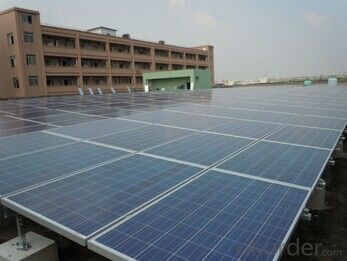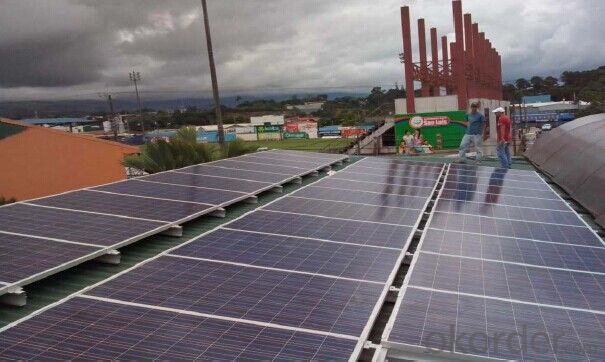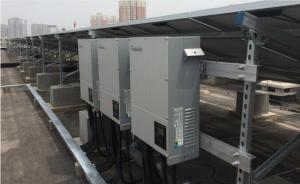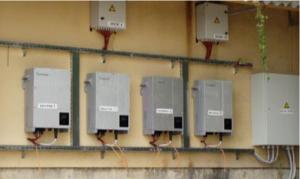Solar Power Inverter 1000W-3000W Grid Tie Solar Inverter
- Loading Port:
- Shekou
- Payment Terms:
- TT or LC
- Min Order Qty:
- 10 pc
- Supply Capability:
- 100000 pc/month
OKorder Service Pledge
OKorder Financial Service
You Might Also Like
Solar power inverter 1000W-3000W grid tie solar inverter
Specifications
Maximum efficiency 97.8%, wide input voltage range
Internal DC switch
Transformerless GT topology
Compact design
1500 2000 3000 4400 5000TL
General Descriptions
Leading-Edge Technology, CE,TUV ,VDE , SAA,DK5940 Certicificates.
> Maximum efficiency of 97.8 % and wide input voltage range
> Internal DC STWTICH
> Transformerless H6 topology
> Compact Design
> MPPT control
> MTL-String
> RS485 RS432 bluetooth Technology
> Comprehensive Growatt warranty program
> Easy country configuration, easy installation
> Multi-language display
Communications
> RS485 /GPRS interfaces
> Computer monitoring software
Safety
> Full protection functions:DC reverse polarity, AC short-circuit protection, ground fault monitoring, grid monitoring, integrate all-pole sensitive, leakage current monitoring unit.
> Standards complied: EN61000-6-1, EN61000-6-2, EN61000-6-3, EN61000-6-4,EN61000-3-2, EN50178, VDE0126-1-1,IEC-62109
FAQ
1. Have any design tool and how to use it?
Shine Design is the system design software just for inverters, It can conduct installers to figure out panel numbers for a system, panel numbers for each string, and which inverter model is suitable for the system. Moreover, it can print a design report after input all necessary parameters, can calculate DC/AC wire wastage, annual generation, etc.
2. Does the inverter have monitoring solutions for residential system?
For small rating system, we have wired two monitoring solution (ShineNet via RS232 or RS485). (a) Local wireless monitoring solution (ShineVision via RF module communication) (b) Global wireless monitoring solution (WIFI module via WIFI network)
3. Do you have free solution for monitoring?
ShineNet is an inverter monitoring software run in Windows XP, Windows Vista, Windows 7 operating system. It can monitor inverter via RS232 (or RS232 convert to USB cable) and RS485 wire connection. Customers can purchase the cable locally to get the inverter monitored, it is simple.



Technical Specifications
Model Specifications | 1500 | 2000 | 3000 | 4000 | 4400 | 5000 |
Input data(DC) | ||||||
Max. DC power | 1800W | 2300W | 3200W | 4200W | 4600W | 5000W/5200W* |
Max. DC voltage | 450V | 500V | 500V | 580V | 580V | 580V |
Start voltage | 150V | 150V | 150V | 150V | 150V | 150V |
PV voltage range | 100V-450V | 100V-500V | 100V-500V | 100V-580V | 100V-580V | 100V-580V |
MPP work voltage range/ nominal voltage | 120V-450V/360V | 120V-500V/360V | 120V-500V/360V | 120V-580V/360V | 120V-580V/360V | 120V-580V/360V |
Full load dc voltage range | 175V-450V | 195V-450V | 250V-450V | 250V-500V | 250V-500V | 250V-500V |
Max. input current | 10A | 12A | 15A | 20A | 20A | 20A |
Max. input current per string | 10A | 12A | 15A | 20A | 20A | 20A |
Number of independent MPP trackers /strings per MPP tracker | 1/1 | 1/2 | 1/2 | 1/3 | 1/3 | 1/3 |
Output (AC) | ||||||
Rated AC output power | 1600W | 2000W | 2850W | 3680W | 4200W | 4600W |
Max. AC power | 1650W | 2200W | 3000W | 4000W | 4400W | 4600/5000W* |
Max. output current | 8A | 11A | 15A | 16A | 21A | 22.7A |
AC nominal voltage; range | 220,230,240V; 180Vac-280Vac | 220,230,240V; 180Vac-280Vac | 220,230,240V; 180Vac-280Vac | 220,230,240V; 180Vac-280Vac | 220,230,240V; 180Vac-280Vac | 220,230,240V; 180Vac-280Vac |
AC grid frequency; range | 50,60H;±5 Hz | 50,60H;±5 Hz | 50,60H;±5 Hz | 50,60H;±5 Hz | 50,60H;±5 Hz | 50,60H;±5 Hz |
Power factor | 1 | 1 | 1 | 1 | 1 | 1 |
THDI | <3%< p=""> | <3%< p=""> | <3%< p=""> | <3%< p=""> | <3%< p=""> | <3%< p=""> |
AC connection | Single phase | Single phase | Single phase | Single phase | Single phase | Single phase |
Efficiency | ||||||
Max. efficiency | 97% | 97% | 97% | 97.8% | 97.8% | 97.8% |
Euro weighted efficiency | 96.5% | 96.5% | 96.5% | 97.4% | 97.4% | 97.4% |
MPPT efficiency | 99.5% | 99.5% | 99.5% | 99.5% | 99.5% | 99.5% |
Protection devices | ||||||
DC reverse polarity protection | yes | yes | yes | yes | yes | yes |
DC switch rating for each MPPT | yes | yes | yes | yes | yes | yes |
Output over current protection | yes | yes | yes | yes | yes | yes |
Output over voltage protection-varistor | yes | yes | yes | yes | yes | yes |
Ground fault monitoring | yes | yes | yes | yes | yes | yes |
Grid monitoring | yes | yes | yes | yes | yes | yes |
Integrated all - pole sensitive leakage current monitoring unit | yes | yes | yes | yes | yes | yes |
General Data | ||||||
Dimensions (W / H / D) in mm | 360/329/132 | 360/329/132 | 360/329/132 | 406/406/192 | 406/406/192 | 406/406/192 |
Weight | 11.5KG | 11.7KG | 12.2KG | 21KG | 21KG | 21KG |
Operating temperature range | –25°C ... +60°C (-13...+140°F) with derating above 50°C /122°F | –25°C ... +60°C (-13...+140°F) with derating above 50°C /122°F | –25°C ... +60°C (-13...+140°F) with derating above 50°C /122°F | –25°C ... +60°C (-13...+140°F) with derating above 50°C /122°F | –25°C ... +60°C (-13...+140°F) with derating above 50°C /122°F | –25°C ... +60°C (-13...+140°F) with derating above 50°C /122°F |
Noise emission (typical) | ≤ 25 dB(A) | ≤ 25 dB(A) | ≤ 25 dB(A) | ≤ 25 dB(A) | ≤ 25 dB(A) | ≤ 25 dB(A) |
Altitude | 2000m(6560ft) without derating | |||||
Self-Consumption night | < 0.5 W | < 0.5 W | < 0.5 W | < 0.5 W | < 0.5 W | < 0.5 W |
Topology | transformerless | transformerless | transformerless | transformerless | transformerless | transformerless |
Cooling concept | Natural | Natural | Natural | Natural | Natural | Natural |
Environmental Protection Rating | IP65 | IP65 | IP65 | IP65 | IP65 | IP65 |
Relative humidity | 95% | 95% | 95% | 95% | 95% | 95% |
Features | ||||||
DC connection | H4/MC4(opt) | H4/MC4(opt) | H4/MC4(opt) | H4/MC4(opt) | H4/MC4(opt) | H4/MC4(opt) |
AC connection | Screw terminal | Screw terminal | Screw terminal | Screw terminal | Screw terminal | Screw terminal |
Display | LCD | LCD | LCD | LCD | LCD | LCD |
Interfaces: RS485/RS232/Bluetooth / RF/Zigbee/Wifi | yes/yes/opt/opt/opt/opt | yes/yes/opt/opt/opt/opt | yes/yes/opt/opt/opt/opt | yes/yes/opt/opt/opt/opt | yes/yes/opt/opt/opt/opt | yes/yes/opt/opt/opt/opt |
Warranty: 5 years / 10 years | yes /opt | yes /opt | yes /opt | yes /opt | yes /opt | yes /opt |
Certificates and approvals | CE,VDE 0126-1-1,DK5940,G83/1-1,G59/2,RD1663,EN50438,VDE-AR-N4105,CEI-021,IEC-62109,ENEL-Guide | CE,G83/1-1 | CE,VDE 0126-1-1,DK5940,G83/1-1,G59/2,RD1663,EN50438,IEC-62109,ENEL-Guide | |||
- Q:Can a solar inverter be used in systems with multiple solar arrays?
- Yes, a solar inverter can be used in systems with multiple solar arrays. The inverter has the capability to convert the DC power generated by each solar array into AC power that can be used in the electrical system. It can manage and optimize the power output from multiple arrays, ensuring efficient and reliable operation of the overall solar system.
- Q:Can a solar inverter be used with a solar water heating system?
- No, a solar inverter cannot be directly used with a solar water heating system. A solar inverter is specifically designed to convert the direct current (DC) electricity generated by solar panels into alternating current (AC) that can be used to power household appliances or fed into the grid. On the other hand, a solar water heating system utilizes the sun's energy to heat water directly, without the need for an electrical conversion process. Therefore, they are two distinct technologies with different purposes and cannot be directly combined.
- Q:How does MPPT improve the efficiency of a solar inverter?
- MPPT, or Maximum Power Point Tracking, improves the efficiency of a solar inverter by constantly adjusting the operating voltage and current to maximize the power output of the solar panels. This optimization ensures that the inverter extracts the maximum available power from the solar panels, thereby increasing overall system efficiency and maximizing the energy harvest from the solar installation.
- Q:How does a solar inverter handle voltage and frequency variations caused by load shedding?
- A solar inverter is designed to handle voltage and frequency variations caused by load shedding by having built-in mechanisms and control systems. When load shedding occurs and the grid voltage or frequency deviates from the normal range, the solar inverter detects these variations and adjusts its operation accordingly. To handle voltage variations, the solar inverter employs a voltage regulation system. It continuously monitors the grid voltage and compares it with the standard voltage level. If the grid voltage decreases or increases beyond the acceptable range, the inverter adjusts its internal voltage conversion process to maintain a stable output voltage. This ensures that the connected solar panels continue to generate power within the acceptable voltage limits, minimizing any negative effects due to voltage fluctuations. Similarly, for frequency variations caused by load shedding, the solar inverter has a frequency regulation mechanism. It monitors the grid frequency and compares it with the standard frequency level. In cases of frequency deviations, the inverter adjusts its internal synchronization process to match the grid frequency. This allows the inverter to synchronize with the grid and feed the generated solar power in a manner that is compatible with the grid's frequency. In addition to voltage and frequency regulation, solar inverters often have additional functionalities to enhance their ability to handle variations caused by load shedding. These may include features such as anti-islanding protection, which ensures that the solar system disconnects from the grid during a power outage to prevent safety hazards to utility workers attempting to restore power. Furthermore, some advanced inverters can also have energy storage capabilities, allowing them to store excess solar energy and provide uninterrupted power supply during load shedding events. Overall, solar inverters are specifically designed to handle voltage and frequency variations caused by load shedding. Through their regulation and control systems, they ensure that the solar power generated from the panels remains stable and compatible with the grid, providing a reliable and efficient power supply even during challenging grid conditions.
- Q:What is the role of a solar inverter in power factor correction?
- The role of a solar inverter in power factor correction is to convert the direct current (DC) generated by the solar panels into alternating current (AC) that can be used by the electrical grid. In doing so, the solar inverter ensures that the AC power being fed into the grid has a power factor close to unity, which means it is efficient and does not cause any unnecessary strain on the electrical system. This helps to improve the overall power quality and efficiency of the solar energy system.
- Q:What is the efficiency of a solar inverter?
- The efficiency of a solar inverter refers to how effectively it converts the direct current (DC) power generated by solar panels into alternating current (AC) power that can be used to power household appliances or be fed back into the grid. It is typically measured as a percentage and represents the amount of DC power that is successfully converted into usable AC power. A higher efficiency indicates a more effective conversion process, resulting in less energy loss and maximizing the overall output of the solar system.
- Q:How does a solar inverter handle variations in solar panel degradation over time?
- A solar inverter handles variations in solar panel degradation over time by continuously monitoring the power output of the solar panels and adjusting its operations accordingly. As solar panels degrade over time, their efficiency decreases, resulting in a decrease in power output. The inverter detects this decrease and adapts its operation to maximize the power conversion and maintain optimal performance. This ensures that the solar energy harvested from the panels is efficiently converted and utilized, despite variations in panel degradation.
- Q:Can a solar inverter be used with different types of solar panel mounting systems?
- Yes, a solar inverter can be used with different types of solar panel mounting systems. The solar inverter is designed to convert the direct current (DC) generated by the solar panels into alternating current (AC) that can be used to power appliances and electrical devices. Regardless of the mounting system, as long as the solar panels are connected to the solar inverter, it can efficiently convert the generated energy for use.
- Q:How does a solar inverter handle temperature variations?
- A solar inverter is designed to handle temperature variations by incorporating advanced thermal management systems. These systems ensure that the inverter operates within a specified temperature range, typically between -25 to 60 degrees Celsius. The inverter uses internal fans, heat sinks, and sometimes liquid cooling mechanisms to dissipate heat generated during operation. Additionally, the inverter may have temperature sensors that monitor the internal and external temperatures, allowing it to adjust its performance and efficiency accordingly. This temperature management enables the solar inverter to operate optimally and maintain its reliability even in extreme temperature conditions.
- Q:How does a solar inverter affect the overall aesthetics of a solar installation?
- A solar inverter does not have a significant impact on the overall aesthetics of a solar installation. Inverters are typically mounted in discreet locations, such as on the side of a building or inside a garage, where they are not visible from the street or prominent areas. Therefore, the inverter's presence does not greatly affect the visual appeal of the solar system.
1. Manufacturer Overview |
|
|---|---|
| Location | |
| Year Established | |
| Annual Output Value | |
| Main Markets | |
| Company Certifications | |
2. Manufacturer Certificates |
|
|---|---|
| a) Certification Name | |
| Range | |
| Reference | |
| Validity Period | |
3. Manufacturer Capability |
|
|---|---|
| a)Trade Capacity | |
| Nearest Port | |
| Export Percentage | |
| No.of Employees in Trade Department | |
| Language Spoken: | |
| b)Factory Information | |
| Factory Size: | |
| No. of Production Lines | |
| Contract Manufacturing | |
| Product Price Range | |
Send your message to us
Solar Power Inverter 1000W-3000W Grid Tie Solar Inverter
- Loading Port:
- Shekou
- Payment Terms:
- TT or LC
- Min Order Qty:
- 10 pc
- Supply Capability:
- 100000 pc/month
OKorder Service Pledge
OKorder Financial Service
Similar products
New products
Hot products
Hot Searches
Related keywords
































